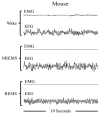Functions and Mechanisms of Sleep
- PMID: 28413828
- PMCID: PMC5390528
- DOI: 10.3934/Neuroscience.2016.1.67
Functions and Mechanisms of Sleep
Abstract
Sleep is a complex physiological process that is regulated globally, regionally, and locally by both cellular and molecular mechanisms. It occurs to some extent in all animals, although sleep expression in lower animals may be co-extensive with rest. Sleep regulation plays an intrinsic part in many behavioral and physiological functions. Currently, all researchers agree there is no single physiological role sleep serves. Nevertheless, it is quite evident that sleep is essential for many vital functions including development, energy conservation, brain waste clearance, modulation of immune responses, cognition, performance, vigilance, disease, and psychological state. This review details the physiological processes involved in sleep regulation and the possible functions that sleep may serve. This description of the brain circuitry, cell types, and molecules involved in sleep regulation is intended to further the reader's understanding of the functions of sleep.
Keywords: EEG; cognition; energy; function; glia; immunity; mechanism; neurons; sleep.
Figures



References
-
- Etinger U, Kumari V. Effects of sleep deprivation on inhibitory biomarkers of schizophrenia: implications of drug development. Lancet Psychiatry. 2015;2:1028–1035. - PubMed
Grants and funding
LinkOut - more resources
Full Text Sources
Other Literature Sources
